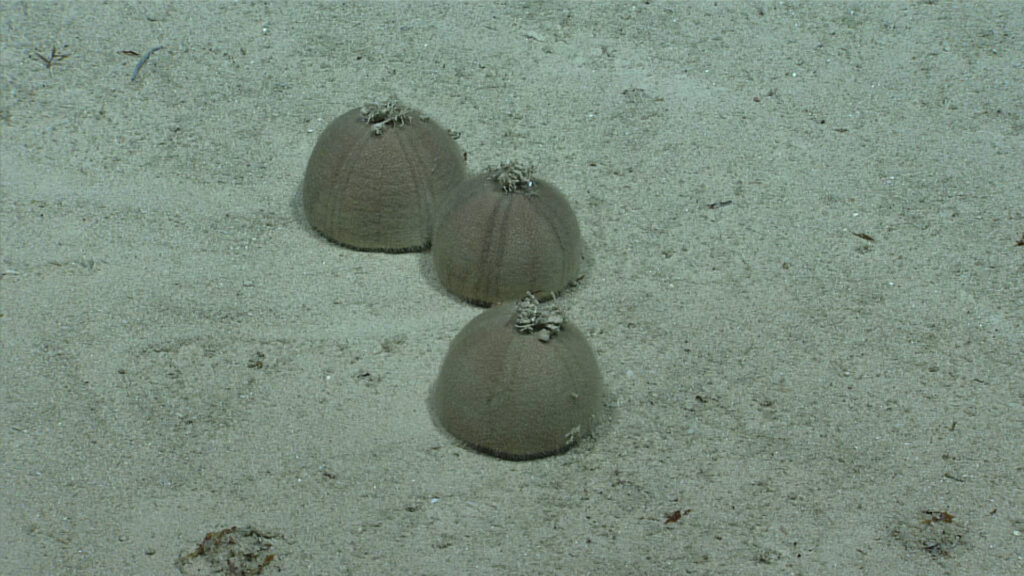
Scientists witnessed something deeply weird nearly 1,400 feet under the sea off St. Croix’s southwest coast — and they’re giddy about it.
A remote-controlled submarine spotted a gathering of 35 to 60 deep-sea urchins. They’re unusual creatures to find on their own but extraordinarily rare in such a large group, said Chris Mah, a scientist at the Smithsonian’s Washington, D.C. National Museum of Natural History.
And that’s just the beginning of the oddity.
The only other known observation of this sort of deep-sea urchin meet-up happened in the 1990s, where scientists witnessed the animals spawning, Mah said Wednesday.
“Other than being seen by some scientists and briefly documented in the ‘90s, this is the first time we’ve seen one of these in detail. We’re literally looking at the first time this has been documented with a high-quality video, with a decent number of individuals,” he said. “We’re on the first step of all this. It’s true exploration.”
Very little is known about the behavior of Conolampas sigsbei, also known as irregular urchins, Mah said. The dumpling-shaped creatures are cousins of the long-spined urchins commonly found in shallow waters around the Virgin Islands but have much shorter, hair-like spines. They’re closely related to sand dollars, also known as sea biscuits.
With no eyes or obvious means of communication, scientists don’t know how the animals find each other.
“Why and how do they get together? What are they doing down there? Are they feeding? What sorts of attractors are there? It’s possible that they can just sort of sense each other. I mean, not sense in a magic way,” he said. “This is part of the mystery. This is why, the more you ask the basic questions, the more kind of crazy it sounds.”
The creatures may have gathered because of an ample food source — grinding sand for decaying organic matter that filters down to the seabed. Mah was convinced the gathering, which scientists from the National Oceanic and Atmospheric Administration dubbed a meet and greet, was no accident.
“Sea urchins are relatively infrequent. So, when you see a spike of 50 of them, even if it’s kind of spread out, that’s not a coincidence. So, yeah, why is there a huge aggregation of these suddenly,” he wondered.
Once together, they may have spawned or were about to when the submarine showed up. The scientists didn’t actually observe the reproductive acts, which would have involved streams of fluid coming from the creatures and blending in the water, Mah said.
Strange as it may sound so far, here’s where it gets really weird. All the urchins the robotic submarine filmed that day in August were wearing hats. Yes, hats, all in roughly the same location atop their bodies.
“They were wearing little bits of debris. Some of it was sargassum. Some of it was little stones,” Mah said.
Shallow water urchins gather rocks to protect themselves from ultraviolet lights or to camouflage against predators. It’s called the collector’s response. But almost no sunlight penetrates 411 meters under the sea where the St. Croix urchins live, he said. So why the hats?
“It’s not entirely clear why they have this figurative hat. Why are they wearing debris — sargassum, shells, rocks. And it wasn’t just a couple of them. All of them had it. And it was all localized to one spot on the top of each animal,” Mah said. “Don’t get me wrong. I know how all this sounds.”
The debris isn’t just accidentally stuck there either. Mah said the urchins have the ability to add or remove the adornment as they wish.
In a video of the encounter NOAA researchers liken it to a human gelling their hair into a mow-hawk.
“It’s like a Victorian hat party,” Mah said in the video.
But the scientist wasn’t willing to limit his speculation just because it sounds weird. It could get even weirder.
Each Conolampas sigsbei leaves a trail as it pushes its way through the sand — a sort of seafloor wake the width of its body. Mah wondered if these underwater markings carry some meaning.
“Maybe we’re not giving them enough credit,” he said.





